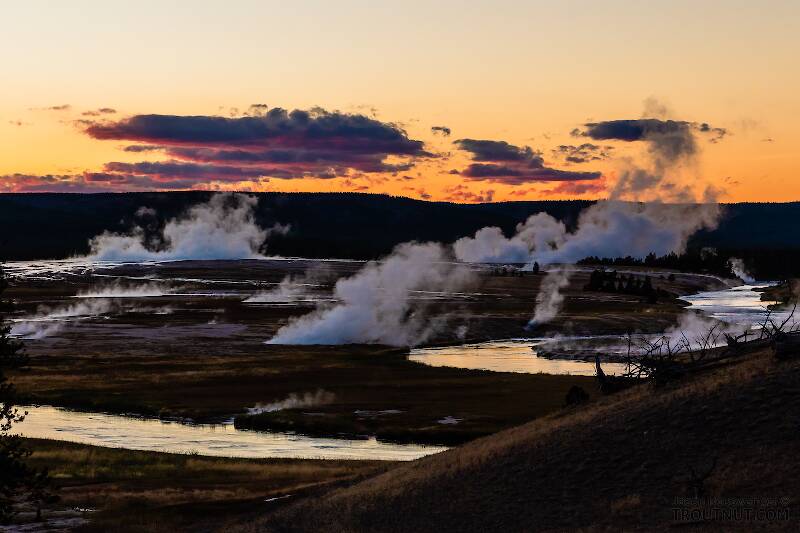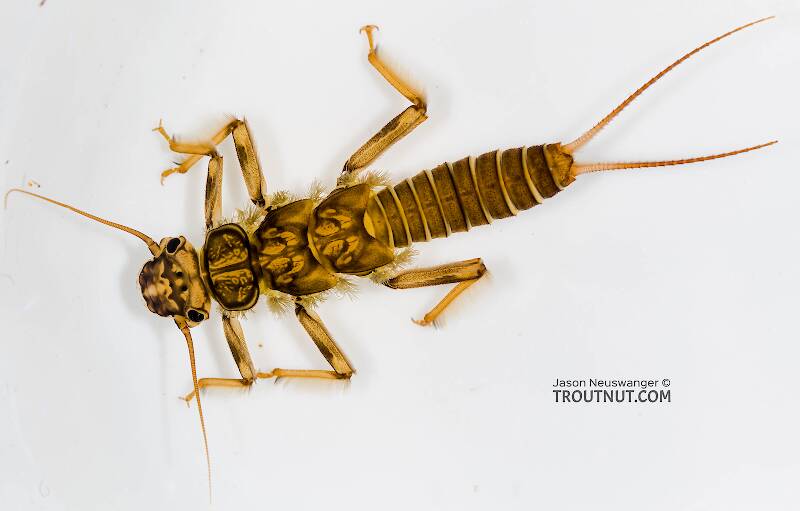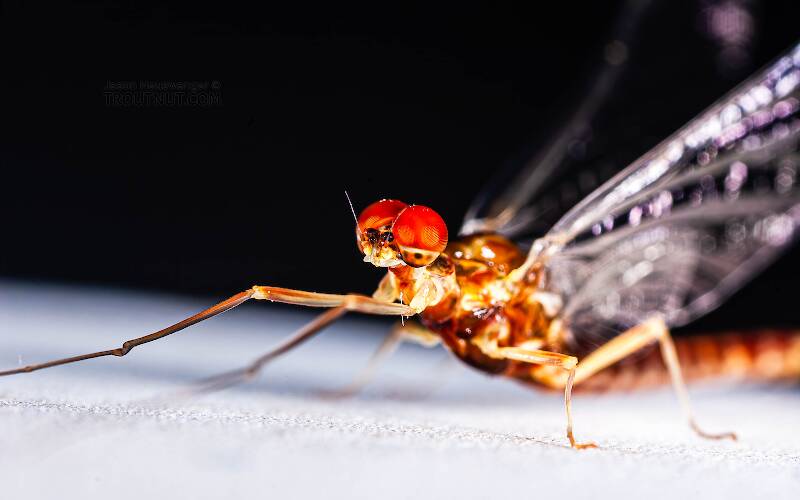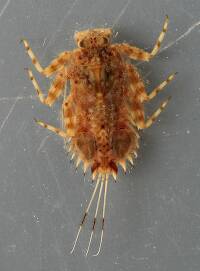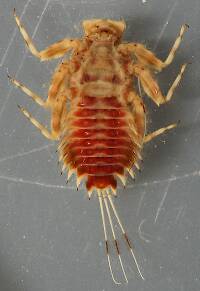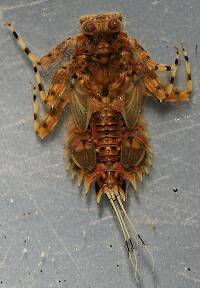
Salmonflies
Pteronarcys californica
The giant Salmonflies of the Western mountains are legendary for their proclivity to elicit consistent dry-fly action and ferocious strikes.
Featured on the forum

Troutnut is a project started in 2003 by salmonid ecologist Jason "Troutnut" Neuswanger to help anglers and
fly tyers unabashedly embrace the entomological side of the sport. Learn more about Troutnut or
support the project for an enhanced experience here.
This topic is about the Mayfly Genus Ephemerella
This genus contains the legendary Hendricksons and Sulphurs of the East and the equally important Pale Morning Duns of western waters.No scientific name in American angling literature is more renowned and at the same time capable of more confusion than the genus name "Ephemerella." It is important that anglers have a good overall grasp of its taxonomic history if they are to make any sense out of the rich literary heritage involving this mayfly name.
By the time American angling literature began to take serious note of entomology in the decades of the early to mid 20th century, Ephemerella was considered a "super-genus" in the family Baetidae, containing all of the important species to anglers in the subfamily Ephemerellinae. Taxonomists organized them by association with "type" species that were referred to as "groups" within this very large and unruly genus.
This organizational structure held sway until the 70's when they were recognized as separate from the Baetidae with their own family, the Ephemerellidae. The "groups" (after a little name changing and reorganization) were given subgenus status, but in conformance with taxonomical convention,the nomenclature retained the use of the name Ephemerella when referring to individual species genus status. More change occurred towards the end of the century as consensus formed around the subgenera achieving full generic status. The broad use of Ephemerella was then dropped in favor of the new generic names.
These changes were necessary in that they addressed many problems exposed in older taxonomies. Unfortunately, all during this period the changes were reported with varying degrees of accuracy and acceptance. For anglers this was exacerbated by the continued use and reliance on older entomology texts in many circles. Be that as it may, recent or updated angler entomologies now recognize that many of the old Ephemerella species are spread out among several genera in the Ephemerellidae family. These include the various Blue-Winged Olives and Western Green Drakes of the Drunella genus as well as several important species scattered in genera like Attenella and Serratella, to name a few.
Despite these revisions in classification, the Ephemerella genus still contains arguably the most important species in North America, and remains a "super-genus" to anglers.
There is a lot of variation; refer to the genus species hatch pages for details.
Example specimens
Trouthunter
Posts: 2
Posts: 2
Trouthunter on Apr 18, 2009April 18th, 2009, 1:28 pm EDT
I was recently told by a close friend of mine that in the southertier of ny ( finger lakes region) that we have very good hatches of pmds. I was hoping that someone could confirm this or otherwise before I tye up patterns. I have seen what I believe are sulphurs with slightly the same body and wing coloration but again thought that these couldn't be the famed insect.
GONZO on Apr 18, 2009April 18th, 2009, 2:49 pm EDT
Trouthunter,
When you hear talk about PMDs being found in the East or Sulphurs being found in the West, it's mostly a name game. Some fly fishers seem confused by recent taxonomic revisions. The species that are traditionally called PMDs in the West are now considered to be synonyms or subspecies of species found in the East:
1. The Western PMD species Ephemerella infrequens and mollitia are now listed as synonyms of E. dorothea infrequens. This Western subspecies is the counterpart of the Eastern subspecies E. dorothea dorothea, the Pale Evening Dun (PED) or Little Sulphur Dun (LSD).
2. The other Western PMD species, Ephemerella inermis and lacustris, are now listed as synonyms of E. excrucians, which is sometimes called a BWO in the East.
So, whether you call them PMDs, PEDs, LSDs, or BWOs, it's really just stirring the bowl of alphabet soup. ;)
When you hear talk about PMDs being found in the East or Sulphurs being found in the West, it's mostly a name game. Some fly fishers seem confused by recent taxonomic revisions. The species that are traditionally called PMDs in the West are now considered to be synonyms or subspecies of species found in the East:
1. The Western PMD species Ephemerella infrequens and mollitia are now listed as synonyms of E. dorothea infrequens. This Western subspecies is the counterpart of the Eastern subspecies E. dorothea dorothea, the Pale Evening Dun (PED) or Little Sulphur Dun (LSD).
2. The other Western PMD species, Ephemerella inermis and lacustris, are now listed as synonyms of E. excrucians, which is sometimes called a BWO in the East.
So, whether you call them PMDs, PEDs, LSDs, or BWOs, it's really just stirring the bowl of alphabet soup. ;)
Falsifly on Apr 19, 2009April 19th, 2009, 8:56 am EDT
Gonzo,
You and the many bug guru’s who contribute, immensely, to this sight, have me in total awe. At first, for me, it was mayfly, caddisfly, stonefly, dragonfly and midge. I then advanced my vocabulary to the “taxonomic rank” (if that is even the correct term) of Order: Ephemeroptera, Trichoptera, Plecoptera, Odonata and Diptera. From there things began to get fuzzy in a sea of change, this became that and that became this, with each succeeding book. Even the Latin pronunciation I found dubious.
In an effort to keep up I find myself in a quandary, should I hit the water and fish the hatch like this guy, displaying his fine catch with the thumbs-up?

Or should I hit the water with study material in hand, like this guy, only to find myself in a tangled mess?

All kidding aside, thanks to the many for the invaluable contributions.
You and the many bug guru’s who contribute, immensely, to this sight, have me in total awe. At first, for me, it was mayfly, caddisfly, stonefly, dragonfly and midge. I then advanced my vocabulary to the “taxonomic rank” (if that is even the correct term) of Order: Ephemeroptera, Trichoptera, Plecoptera, Odonata and Diptera. From there things began to get fuzzy in a sea of change, this became that and that became this, with each succeeding book. Even the Latin pronunciation I found dubious.
You say caley-BEE-tis; I say caley-BAY-tis.
You say moo-TILL-li-dee; I say moo-TILL-li-day.
caley-BEE-tis; caley-BAY-tis,
moo-TILL-li-dee; moo-TILL-li-day.
In an effort to keep up I find myself in a quandary, should I hit the water and fish the hatch like this guy, displaying his fine catch with the thumbs-up?

Or should I hit the water with study material in hand, like this guy, only to find myself in a tangled mess?

All kidding aside, thanks to the many for the invaluable contributions.
Falsifly
When asked what I just caught that monster on I showed him. He put on his magnifiers and said, "I can't believe they can see that."
When asked what I just caught that monster on I showed him. He put on his magnifiers and said, "I can't believe they can see that."
GONZO on Apr 19, 2009April 19th, 2009, 9:33 am EDT
:):):) Ha! Thanks, Falsifly.
Of course, we should all hit the water in any (legal) way that we enjoy. For me, learning about all of the arcana that surrounds the sport has been a lifelong obsession. Although I find that it enriches the experience and has even simplified many aspects of it (particularly the number of flies that I carry astream), I don't expect that everyone shares those interests. That's OK.
I do sometimes wonder if fly fishing isn't just a convenient excuse to remain connected to the streams that I love and the things that live in and around them. Even if that's true, I think it's probably as good a reason as any to fly fish.
As for the Latinized language, the great thing about posting online is that I can use words like Stenochironomus poecilopterus without having to pronounce the damn things! :)
Of course, we should all hit the water in any (legal) way that we enjoy. For me, learning about all of the arcana that surrounds the sport has been a lifelong obsession. Although I find that it enriches the experience and has even simplified many aspects of it (particularly the number of flies that I carry astream), I don't expect that everyone shares those interests. That's OK.
I do sometimes wonder if fly fishing isn't just a convenient excuse to remain connected to the streams that I love and the things that live in and around them. Even if that's true, I think it's probably as good a reason as any to fly fish.
As for the Latinized language, the great thing about posting online is that I can use words like Stenochironomus poecilopterus without having to pronounce the damn things! :)
Quick Reply
Related Discussions
Topic
Replies
Last Reply
0
Jun 29, 2020
by Wiflyfisher
by Wiflyfisher
Re: So is Ep Infrequens now known as Ep Dorothea?
In the Mayfly Species Ephemerella dorothea infrequens by Wbranch
In the Mayfly Species Ephemerella dorothea infrequens by Wbranch
20
Jul 1, 2014
by Crepuscular
by Crepuscular
Re: Public service announcement: PMDs aren't yellow
In Male Ephemerella excrucians Mayfly Dun by Troutnut
In Male Ephemerella excrucians Mayfly Dun by Troutnut
13
Aug 28, 2020
by Wiflyfisher
by Wiflyfisher
3
Jul 22, 2014
by Entoman
by Entoman
10
May 24, 2009
by Wiflyfisher
by Wiflyfisher

